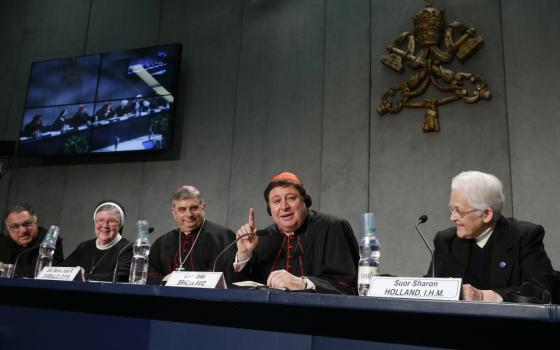National Catholic Reporter's website is hosting a comments page for your discussion about the apostolic visitation report and what it means for the church and future of women religious.
Keep up with all of GSR's coverage of this issue on this series page, which lists all the related stories together.
Related - An apology would have been welcomed
The Vatican’s report on the apostolic visitation released Tuesday was an affirmation of women religious in the United States – but was it yet another possible sign of a change in tone at the highest levels of the Catholic church?
With its calls for dialogue and collaboration – and a nod toward greater decision making by women – the report follows October’s Synod on the Family, where open debate of topics that had not previously been up for discussion appeared to signal to some a sea change in how the Vatican operates.
“They are changing their paradigm. They want a climate more conducive to dialogue,” said Deborah Rose-Milavec, executive director of FutureChurch and spokesperson for the Nun Justice Project, a coalition of 15 progressive Catholic organizations in the United States.
“We have cardinals and prelates more willing to listen to dialogue, and more willing to listen to women. We are moving in a new direction.”
The reception of the report is a major shift from the reception of the 2008 announcement of the apostolic visitation, which many saw as a punitive inquiry into women religious in the United States. The Vatican investigation was launched by the congregation for religious life with the approval of Pope Benedict XVI. Likely the largest such investigation in church history, it involved inquiry into some 341 female religious institutes in the U.S. that include about 50,000 women.
At the press conference announcing the report, Cardinal João Bráz de Aviz, prefect of the religious congregation that produced it, said the roles of women need to be reexamined.
“We joyfully welcome the many recent statements by Pope Francis about the indispensable and unique contributions of women to society and the Church,” Bráz de Aviz said. “I assure you that this Congregation is committed to collaborate in the realization of Pope Francis’ resolve that ‘the feminine genius’ find expression in the various settings where important decisions are made, both in the Church and in social structures. We will continue to work to see that competent women religious will be actively involved in ecclesial dialogue regarding ‘the possible role of women in decision-making in different areas of the Church’s life,’” quoting Evangelii Gaudium.
But is the church ready for the collaboration and dialogue called for in the report? Social Service Sr. Simone Campbell, executive director of the national Catholic social justice lobby NETWORK, said only time will tell.
“They’re encouraging dialogue. Well, we [as women religious] have worked 50 years at dialogue,” Campbell said. “It requires shared power, mutual respect, and prayerful respect for where the Spirit is leading us. Do they really want to learn that?”
Whether the change is real or not, even talking about change is a dramatic shift, she said.
Loretto Sr. Donna Day, one of the authors of Power of Sisterhood: Women Religious Tell the Story of the Apostolic Visitation, said the tensions between women religious and the Vatican will lessen if the church follows through.
“I think the healing process can start,” Day said, “if the dialogue that the report indicates as being important – they even mentioned it specifically – if that dialogue becomes a reality. I think that's a very positive outcome.”
St. Joseph Sr. Jean Wincek, also one of the authors of Power of Sisterhood, said there’s no question the words being used are different now – and they’re words women religious are used to hearing.
“I’m not sure there’s been time for the conversation to change yet, but surely the language has changed,” Wincek said. “Several people brought up the idea that the language seems to be shifting. It’s language in which we can recognize ourselves, and when language changes, the conversation can change.”
FutureChurch’s Rose-Milavec said it’s difficult to explain how different the landscape would become if the church follows through: Sisters have a collaborative decision-making process, while the church is hierarchical.
“It goes deep. It’s the difference between the way women religious have come to their decision making processes and their ways of leading communities, and the experiences we’ve had with the bishops and the top-down model,” she said.
Craig Gould, director of Catholics on Call, said the change in tone could have a profound effect on the future of the church.
“I think young adult Catholics are and have been raised in an environment of collaboration and cooperation. It's the language that they speak. There was a sense before this document that the relationship between the offices at the Vatican and the community of sisters was not in collaboration, but it was . . . either dictatorial or authoritarian,” Gould said. “I think there's real concern that that's how this was being played out.”
Gould said young Catholics may now see in the church a model they can embrace.
“Young adults are really sensitive to a spirit of egalitarian equality, and so for young adults to hear this come out now – whether they're young adults who are actually sisters or just the larger young adult population in general – their world view is one of cooperation and collaboration,” he said. “That’s a value they hold – so when that doesn't happen, they immediately devalue whoever is dismissing collaboration.”
Notre Dame de Namur Sr. Kristin Matthes noted that she was born the year the Second Vatican Council ended, and so has never known anything but its calls for working together.
“As a younger sister, my experience of religious life has been inter-congregational,” Matthes said. “And so, I think seeing us on the same theme, going in the same direction, hoping for the same thing was really powerful and I just hope that we can continue to cultivate that kind of sisterhood.”
She said she also appreciates that the report called on women religious to examine everything they do.
“I really loved the sense of naming areas of challenge, but naming them in such a way that they were real invitations to look together at how we can continue to be a presence of goodness and justice and peace,” Matthes said.
St. Joseph Sr. Marcia Allen said the report affirms the views of women religious, that they have been following the renewal called for by Vatican II. Allen is president of the Sisters of St. Joseph of Concordia and president-elect of the Leadership Conference of Women Religious, which represents about 80 percent of the women religious in the United States.
“It recommends things that we have always been doing. And so we can take this document and continue to ask ourselves questions as a community and continue to examine was in which we can continue or improve,” Allen said. “At the same time, it opens the door to talk with lay persons and with bishops, with clergy where we serve – just to talk about how we do things, why we do things as we do and then what can we do together. There's a great encouragement here for dialogue and collaboration.”
Francis X. Clooney, a Jesuit priest and professor of divinity and comparative theology at Harvard Divinity School, where he is also director of the Center for the Study of World Religions, echoed the idea that the report praises women religious for following Vatican II rather than criticizing them for it, even though the number of sisters has fallen dramatically since then.
“The document doesn’t say, ‘If you hadn’t made that change since Vatican II, you wouldn’t have that problem,’” Clooney said.
That, too, seems to be a big change, said Sr. Mary Ann Zollmann, a Sister of the Charity of the Blessed Virgin Mary, and an editor and one of the authors of Power of Sisterhood.
“Part of what has happened over the last 50 years is we have lived in the unfolding implications of Vatican II. But women religious and the church have looked at Vatican II from differing perspectives, different understandings of what Vatican II calls us to do,” Zollmann said. “We women religious, many of us, believe we’ve been obedient and faithful in every step we’ve taken since Vatican II, but there’s another perspective – that we may have misinterpreted what Vatican II was calling for.”
Whether the landscape has changed or not, women religious around the world are watching the experiences of those in the United States – and now they’re taking encouragement from it, said Canadian Saint Anne Sr. Rita Larivée. Larivée is leader of her congregation and President of the Canadian Religious Conference.
“The final report gives me hope, following a few years of uncertainty and doubt about how the Vatican sees women religious, not only in the United States, but throughout the world,” Larivée said. “The report, however, could have been stronger in its affirmation of women religious in the U.S. and their commitment to a life centered on Christ. For, if nothing else is evident, this stands out as one of the hallmarks of the tradition these women have lived since their founding days.”
[Dawn Cherie Araujo is staff writer for Global Sisters Report. Follow her on Twitter. Dan Stockman is national correspondent for Global Sisters Report. Follow him on Twitter or on Facebook. Global Sisters Report’s international liaison, Presentation of the Blessed Virgin Mary Sr. Joyce Meyer, contributed to this report.]


